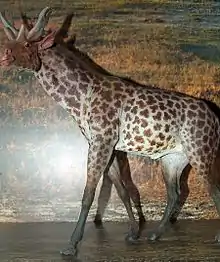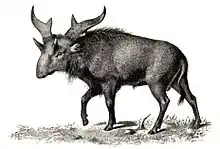Sivatherium
Sivatherium ("Shiva's beast", from Shiva and therium, Latinized form of Ancient Greek θηρίον - thēríon) is an extinct genus of giraffids that ranged throughout Africa to the Indian subcontinent. The species Sivatherium giganteum is, by weight, one of the largest giraffid known, and also one of the largest ruminants of all time.[3] The Afro-Asiatic species, S. maurusium, was once placed within the genus "Libytherium".
| Sivatherium | |
|---|---|
 | |
| Skeleton of S. giganteum | |
| Scientific classification | |
| Kingdom: | Animalia |
| Phylum: | Chordata |
| Class: | Mammalia |
| Order: | Artiodactyla |
| Family: | Giraffidae |
| Subfamily: | †Sivatheriinae |
| Genus: | †Sivatherium Falconer & Cautley, 1836[1][2] |
| Species | |
| |
| Synonyms | |
| |
Sivatherium originated during the Late Miocene (around 7 ma) in Africa and survived through to the late Early Pleistocene (Calabrian)[4] S. giganteum remains have been recovered from the Himalayan foothills, dating around 1 million years ago. Suggestions have been made that S. maurusium may have gone extinct as recently as 8,000 years ago, as depictions that resemble it are known from ancient rock paintings in the Sahara[5] and Central West India.[6] But these claims are not substantiated by fossil evidence, and the depictions likely represent other animals.[7]
Description



Sivatherium resembled the modern okapi, but was far larger, and more heavily built, being about 2.2 m (7.2 ft) tall at the shoulder, 3 m (9.8 ft) in total height with a weight up to 400–500 kg (880–1,100 lb).[8] A newer estimate has come up with an estimated body mass of about 1,250 kg (2,760 lb).[3] This would make Sivatherium one of the largest known ruminants, rivalling the modern giraffe and the largest bovines. This weight estimate is thought to be an underestimate, as it does not take into account the large horns possessed by males of the species. Sivatherium had a wide, antler-like pair of ossicones on its head, and a second pair of ossicones above its eyes. Its shoulders were very powerful to support the neck muscles required to lift the heavy skull.[5]
Diet
A dental wear analysis of S. hendeyi from the Early Pliocene of South Africa found that the teeth were brachyodont, but had a higher hypsodonty than a giraffe, and that it was best classified as a mixed feeder, being able to both graze and browse.[9]
References
- Sivatherium in the Paleobiology Database
- Falconer, Hugh; Cautley, P. T. (1836). "Sivatherium giganteum, a new fossil ruminant genus, from the valley of the Markanda, in the Sivalik branch of the Sub-Himalayan Mountains". Journal of the Asiatic Society of Bengal: 38–50.
- Basu, Christopher; Falkingham, Peter L.; Hutchinson, John R. (January 2016). "The extinct, giant giraffid Sivatherium giganteum: skeletal reconstruction and body mass estimation". Biology Letters. 12 (1): 20150940. doi:10.1098/rsbl.2015.0940. PMC 4785933. PMID 26763212.
- "Fossilworks: Sivatherium". fossilworks.org. Retrieved 2020-04-11.
- Palmer, D., ed. (1999). The Marshall Illustrated Encyclopedia of Dinosaurs and Prehistoric Animals. London: Marshall Editions. p. 278. ISBN 978-1-84028-152-1.
- "Rock paintings show species that roamed India". www.newindianexpress.com. Retrieved 2016-09-14.
- Naish, Darren (April 25, 2011). "What happened with that Sumerian 'sivathere' figurine after Colbert's paper of 1936? Well, a lot". Tetrapod Zoology.
- http://www.geocities.ws/rsn_biodata/Data/Sivatherium_giganteum.html (in Portuguese)
- Franz-Odendaal, Tamara A. Solounias, Nikos. Comparative dietary evaluations of an extinct giraffid (sivatherium hendeyi) (mammalia, giraffidae, sivatheriinae) from Langebaanweg, South Africa (Early Pliocene). OCLC 631971239.CS1 maint: multiple names: authors list (link)
Further reading
- Barry Cox, Colin Harrison, R.J.G. Savage, and Brian Gardiner. (1999): The Simon & Schuster Encyclopedia of Dinosaurs and Prehistoric Creatures: A Visual Who's Who of Prehistoric Life. Simon & Schuster.
- David Norman. (2001): The Big Book Of Dinosaurs. pg. 228, Walcome books.
- After the Dinosaurs: The Age of Mammals (Life of the Past) by Donald R. Prothero
- The Evolution of Artiodactyls by Donald R. Prothero and Scott E. Foss
- Vertebrate Palaeontology by Michael J. Benton and John Sibbick
- Evolving Eden: An Illustrated Guide to the Evolution of the African Large Mammal Fauna by Alan Turner and Mauricio Anton
- Classification of Mammals by Malcolm C. McKenna and Susan K. Bell \
- The Book of Life: An Illustrated History of the Evolution of Life on Earth, Second Edition by Stephen Jay Gould
- World Encyclopedia of Dinosaurs & Prehistoric Creatures: The Ultimate Visual Reference To 1000 Dinosaurs And Prehistoric Creatures Of Land, Air And Sea ... And Cretaceous Eras (World Encyclopedia) by Dougal Dixon
- Eyewitness: Prehistoric Life by William Lindsay
- Walker's Mammals of the World (2-Volume Set) (Walker's Mammals of the World) by Ronald M. Nowak
- Horns, Tusks, and Flippers: The Evolution of Hoofed Mammals by Donald R. Prothero and Robert M. Schoch
External links
| Wikimedia Commons has media related to Sivatherium. |
| Wikispecies has information related to Sivatherium. |